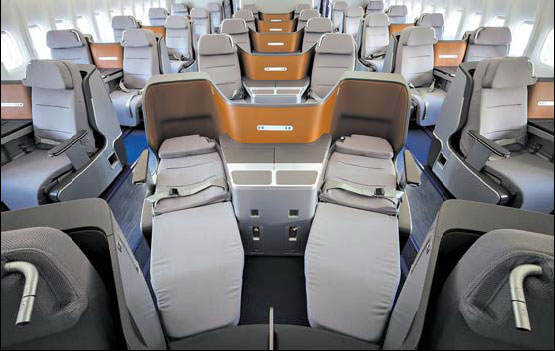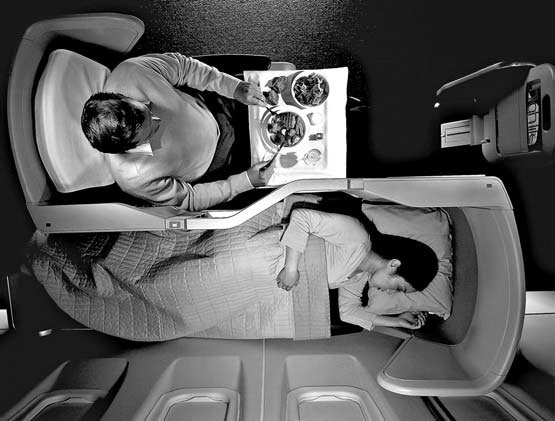Race for a better business class
Updated: 2013-08-18 07:50
By Jad Mouawad(The New York Times)
|
|||||||
|
Lufthansa has placed business-class seat pairs in a V-shape to save space. Benjamin Kilb for The New York Times |
In a confidential test laboratory in an office park near the Frankfurt airport, a small Lufthansa team holed up for five years, refining one of the German airline's most closely guarded secrets. They called it the V concept.
Almost two meters long and close to 60 centimeters wide, the V concept is the German carrier's latest weapon in the fierce competition among global airlines. It is a new business-class seat, and if you are traveling round trip from Frankfurt to New York, it can be yours for about $5,000.
"Business class is where competition really is serious," said Bjorn Bosler, who led Lufthansa's team of dozens of seat designers and engineers.
Billions are being spent on research and development, architects, industrial designers and even yacht designers to pack seats with engineering innovations and fancy features. Just fabricating a single business-class seat can cost up to $80,000; custom-made first-class models run $250,000 to $500,000.
Travelers in business and first class may represent 10 percent to 15 percent of long-haul seats globally, but they account for up to half of the revenue of airlines like Lufthansa or British Airways, said Samuel Engel of ICF SH&E, an aviation consulting firm.

"The seat is one of the few elements that an airline can actually make its own," said Patricia Bastard, an architect and designer who has worked with Air France.
Lufthansa, the world's fourth largest airline in terms of passengers, is investing $4 billion in onboard amenities. But its new business-class seat accounts for roughly a third of that $4 billion investment, said Mr. Bosler.
"Business class today is what first class used to be 10 or 20 years ago," said Jacques Pierrejean, a designer who helped create a first-class semiclosed suite for Emirates.
The business and corporate travel market is by far the most lucrative one for the airlines. Business travelers are expected to spend $273 billion this year on airfares, according to a forecast by the Global Business Travel Association, a 4.3 percent gain from 2012.
"Airlines are rational actors, and where they make their investments tells you where they get their revenues from," Mr. Engel said. "Despite all the technological advances, and e-mail, and videoconferencing, nothing replaces face-to-face meetings. This is why business travel remains so important. And for business travelers to remain productive, they need to fly relatively comfortably over long distances."
That growth in business travel has spurred considerable innovation in the front of the plane.
But finding the right balance among space, comfort and seat features to keep paying passengers comfortable is tricky. Until about five years ago, the norm was for business seats to provide a lie-flat surface at an angle, said Mark Hiller, chief executive of Recaro Aircraft Seating, one of three large seat manufacturers.
Now airlines are increasingly trying to fit fully flat beds for business class, though that typically means losing about 10 percent of the business-class seats. British Airways came up with a design in which half its passengers sit backward, said Peter Cooke, the airline's design manager. It can pack 56 business seats in just seven rows on some Boeing 777s.
"A business-class seat has to be a working desk, an entertainment center, a dining facility, and it's also a bed. It also needs to be comfortable in all those configurations," said James Park, a designer who has worked with Singapore Airlines and Cathay Pacific.

Delta Air Lines, United Airlines and American Airlines have also outlined large investments to install new business-class seats.
"Only a few years ago, all domestic carriers were chasing the commoditization of the business," says Glen W. Hauenstein of Delta. "That didn't work. It was a spiral to the bottom."
In 2007, after reviewing the available business-class seats on the market, Lufthansa decided to design its own. It hired a design firm specializing in furniture that had developed a first-class seat for Virgin Atlantic.
When seats in the front of the cabin get more attention, they create a weight problem.
Airlines, trying to trim weight to cut fuel costs, have sought to balance out heavier seats in the front, in part, by looking for lighter seats in coach. Cutting one kilogram can save as much as $800 a year in fuel cost per seat, according to Mr. Hiller, the Recaro executive.
"In our limited space," said Carole Peytavin, vice president for research and development at Air France,"the question we need to ask is, who is willing to pay for what level of comfort?"
Mr. Hauenstein of Delta said that even with fewer seats in its business-class cabin, an airline can make more money by selling similar seats at different prices.
In business class, there are typically four buckets of prices, ranging from $2,000, for tickets bought far ahead of time, to $6,000 for last-minute walk-ins. If the seat experience is more pleasant, the airline can charge a premium.
"The old cabin was rarely full," Mr. Hauenstein says. "But if demand exceeds supply, that's a good way to make money."
But the seat itself has a limited life, which airlines and designers say is about seven years. After that, it looks stale, and passengers expect a fresh look.
"We've already started thinking about a new seat," said Mr. Bosler of Lufthansa. Maybe this one will come with a cup holder.
The New York Times
|
British Airways' "yin-yang" seating, designed to give passengers more room. British Airways |
(China Daily 08/18/2013 page9)

